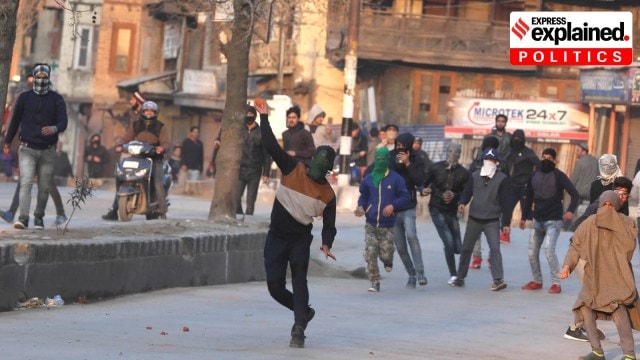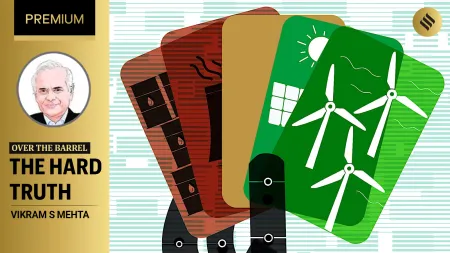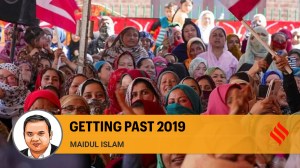- India
- International
After Article 370 scrapping, why incidents of stone-pelting fell in Kashmir
While the security situation in Jammu and Kashmir has improved after August 5, 2019, a new threat is emerging. We explain the factors behind the successes, and the new danger.
 Men throw stones at the police in Srinagar in February 2018. (Express Archive)
Men throw stones at the police in Srinagar in February 2018. (Express Archive)Union Home Minister Amit Shah recently said in Lok Sabha that Article 370 was the foundation of secessionist sentiment in the erstwhile state of Jammu and Kashmir, and suggested that its abolition had cleared the way for end of terrorism in the Valley.
Arguably the most significant legislative decision of the Narendra Modi government has been the Jammu and Kashmir Reorganisation Act, passed by Parliament in August 2019. The law not only abrogated Article 370 and Article 35A, which granted special status to Jammu and Kashmir, it also bifurcated it into two Union Territories of J&K and Ladakh.
The Opposition and the political leadership from Kashmir called this an injustice and breach of trust by the Indian government, but the Centre argued it was necessary to end corruption and terrorism in the region.
Drop in stone-pelting incidents
With an unprecedented number of security forces in Kashmir and harsh action by central agencies such as the NIA, stone pelting incidents in the Valley have plummeted, while terror incidents have witnessed a decline.
Shah on December 6 claimed there was a decline of 70% in incidents of terrorism, 72% in deaths of civilians, and 59% decline in deaths of security force personnel in J&K between UPA (2004-2014) and NDA (2014-2023) periods.

According to data available with MHA till 2021, while in Jan-July 2019, 618 incidents of stone pelting were recorded in the Valley, it fell to 222 for the same period in 2020 and just 76 in 2021. Corresponding injuries to security forces in these incidents also reduced from 64 in (Jan-July) 2019 to just 10 in 2021.
The highest drop was witnessed in injuries to civilians due to pellet guns and baton charge. In Jan-July 2019, 339 civilians sustained injuries in such incidents. This reduced to just 25 in 2021.
Since 2022, the J&K administration has been collating overall law and order data which includes stone pelting incidents among other public order issues. According to this, there were just 20 incidents of ‘law and order’ in J&K in 2022.
Shah on December 6 claimed in Lok Sabha that there was not a single incident of stone pelting in Kashmir in 2023. He compared it with 2010, when 2,654 such incidents took place. He also claimed that in 2010, there were 132 organised strikes in Kashmir, while in 2023 none was recorded.
The government has claimed this is the result of action taken by NIA against Hurriyat leaders — most are in jail currently on charges of terror funding — and crackdown on alleged terror financing. Shah said that NIA has registered 32 cases of terror financing, apart from the UT-level Special Investigation Agency registering 51 cases with regard to terror financing. As many as 229 arrests have been made in these cases.
What has also worked, say security sources, is the government decision to lodge those accused of stone pelting in Uttar Pradesh jails. The hardships associated with it, including being far away from home, has deterred the young from picking up stones, said sources.
Additionally, the NIA has cracked down on various non-governmental organisations, accusing them of promoting secessionist sentiments, fired government officials on charges of being Pakistan sympathisers, and dealt with dissenting voices rather harshly.
More arrests
The period post August 5, 2019 has also seen an increase in the arrest of over-ground workers (OGWs) of militant groups, which shot up from 82 in (Jan-July) 2019 to 178 in 2021.
According to government data, “acts of terrorism” have witnessed a decline of 32% since August 5, 2019 (up to June 6, 2022) compared with the same period preceding the decisions. Similarly, deaths of security forces have seen a drop of 52%, while those of citizens by 14%. A reduction of 14% has also been recorded in “admission of terrorists”.
According to government data, infiltration, which stood at 141 in 2019, has dropped to 48 in 2023.
Concerns remain
Despite these successes, a spate of killings of civilians, particularly of Kashmiri Hindus and non-Kashmiri residents of the Valley, has exposed the fragile nature of Kashmir’s security scenario. More than 50% of all civilians killed in the Valley since August 5, 2019 have been killed in the past eight months.
These attacks began in the backdrop of certain changes that the Centre brought about in laws related to rights over land and domicile in the erstwhile state, which opened the gates for outsiders to settle down in Kashmir, acquire residence rights, and buy property.
The killings have been aided by dropping of small weapons by low-cost drones from across the border and engagement of ‘hybrid terrorists’ by handlers sitting in Pakistan. These ‘hybrid terrorists’, who are essentially part-time militants otherwise leading regular lives in the Valley, have been largely used to target Kashmiri pandits and outsiders. Difficult to identify, they have become a new headache for the security establishment.
This has coincided with attempts by militants to attack Hindu-dominated areas in Jammu, that last saw such attacks in the early 2000s. In 2021, the J&K Police arrested close to 20 militants and recovered multiple IEDs meant for targeting Hindu areas.
The year 2022 started with killing of Hindu civilians in Jammu, something not heard in the division for years. The Jammu border also saw frequent infiltration and gunfight with the Army where more than a dozen Armed Forces personnel have been killed even as the attackers remain elusive.
Shah on December 6 claimed the government was in the process of implementing a “zero terror plan” which was brought into operation three years ago. “I am confident the Modi government is coming back to power in 2024 and by 2026 there will be 100% implementation of the plan,” Shah said.
More Explained
EXPRESS OPINION
May 07: Latest News
- 01
- 02
- 03
- 04
- 05







































